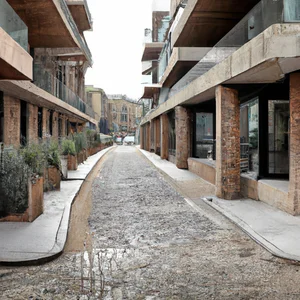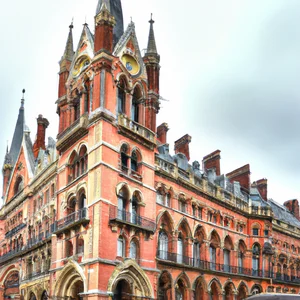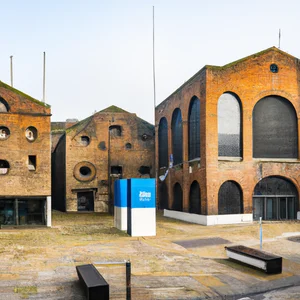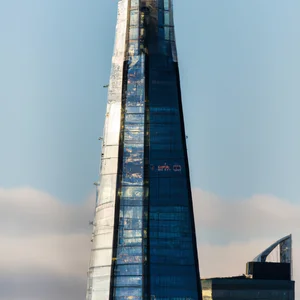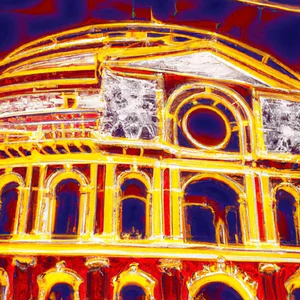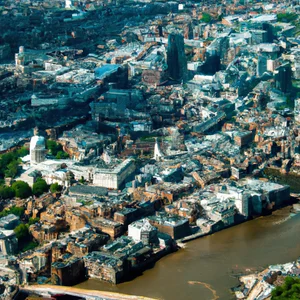Book your experience
London Transport Museum: two centuries of London public transport
Ah, the London Transport Museum! It’s a real gem, if you think about it. In short, we are talking about a place that tells the story of two centuries of public transport in London. It’s not a small thing, eh!
When I went there for the first time, I felt like I was entering a history book, but an adventurous one, full of stories and anecdotes. Can you imagine? From horse-drawn carriages to modern hybrid buses, there is a bit of everything. It’s like taking a leap into the past, but without the time machine, so to speak.
And then there is that strange feeling of seeing the old trams, which remind me of when I went to visit my grandparents in the city as a child. Although, I must admit, today’s vehicles are decidedly more comfortable. Maybe not always on time, but who knows, right? Sometimes I have the impression that the weather in London is acting up, like a naughty child.
There are also some interactive exhibits, which are super fun. Like, you can try driving a bus or immerse yourself in a virtual journey. It’s a bit like being the protagonist of a film, even if, to be honest, I’ve never been a great driver. I think the last time I drove I went around the neighborhood and got lost. Maybe one day I’ll learn!
Well, if you go there, I advise you not to miss the upper floor, where there are some beautiful collectibles and, oh, what about old subway maps? They are a real blast from the past! They make you understand how much the city has changed and how fascinating its evolution is.
In essence, the London Transport Museum is like a journey through time, a sort of journey that makes you reflect on how we move and how the city has transformed. And, who knows, maybe while you’re walking among the various vehicles, you’ll feel like getting on one of them and setting off on a new adventure. In short, there are places that tell stories, and this is exactly one of them!
Discover the history of London’s public transport
A journey through time
I still remember the feeling of amazement I felt the first time I set foot in the London Transport Museum. The air was thick with history, and every corner seemed to whisper stories of travellers, drivers and transport that shaped London. As I looked at an ancient double-decker bus, the Route Master, I imagined the countless passengers who had taken their places in its red cabin, each with their own dream of reaching a destination, from small daily errands to epochal adventures.
A heritage to explore
The London Transport Museum, located in Covent Garden, is not just a place to view historic vehicles; it is a window into over two centuries of innovation in London public transport. From the creation of the first horse-drawn carriages in 1829, through the introduction of the Underground in 1863, to today, the museum illustrates how public transport has changed the lives of Londoners and the city itself. For practical information, the museum is open every day from 10:00 to 18:00, and tickets can be purchased online to avoid queues.
An insider tip
Here’s a secret that only true enthusiasts know: don’t forget to visit the Depot in Acton Town, open only on special occasions. Here you can explore a large collection of historic vehicles and objects that are not on display in the main museum. It’s an experience that will take you even deeper into the fascinating history of London’s public transport.
A cultural impact that lasts
London public transport has played a crucial role in the evolution of urban culture. Not only did it facilitate mobility, but it also influenced architecture, art and even music. Think of iconic songs that evoke scenes of traveling on the subway or bus. Every corner of London is linked to a transport history, making every trip an opportunity to discover the city in a new way.
Sustainability and the future
In an era of growing attention to sustainability, the London Transport Museum is committed to promoting responsible tourism practices. Through educational initiatives and exhibitions on green transport, the museum encourages visitors to think about how public transport can contribute to a greener future for London. Choosing to use public transport, rather than a private car, is a choice that can reduce environmental impact and improve air quality in the capital.
An experience not to be missed
To make your visit even richer, I recommend taking part in one of the museum’s guided tours, where experts tell unique anecdotes and little-known stories. You may discover fascinating details about how public transport has helped shape London society and its cultural fabric.
Myths to dispel
A common myth is that London public transport is always crowded and unreliable. While there are peak times when this may seem true, the transportation system is one of the most efficient and well-organized in the world. With over 300 tube stations and an extensive bus network, London offers unrivaled access to every corner of the city.
A final reflection
As you immerse yourself in the history of the London Transport Museum, ask yourself: how has public transport influenced your daily life? Each bus or subway journey is a piece of a larger mosaic, and discovering the history behind these transports could make you appreciate even more the small daily adventures we experience in this extraordinary city.
Discover the history of London’s public transport
A journey through time
I still remember the first time I found myself on a red double-decker bus in London. As I admired the city through the window, my mind wandered through the stories of past travelers and the history that lingered in every corner. A thought struck me: London public transport is not just a means of getting around, but a real journey through the history of the city. From the first subway line opened in 1863 to current ecological innovations, each stop tells a unique story.
A constantly evolving heritage
London’s public transport system is one of the oldest and most complex in the world. Today, it includes over 1,000 buses, 11 subway lines and various trains and trams, serving millions of passengers every day. Sources such as Transport for London (TfL) provide up-to-date data and practical information on how to get around the city. But what makes this system truly fascinating is the way it reflects London’s social and economic evolution.
An insider tip
If you want an authentic experience, try traveling on one of the last remaining lines with old trams, such as tram 15. Not only will you have the chance to travel on an iconic vehicle, but you will also be able to discover less touristy areas, such as the lively neighborhood of Hackney. Besides, who knows? You might meet an old driver who is willing to tell you fascinating stories about times gone by.
The cultural impact
London public transport is much more than just a way of getting around. It has played a crucial role in the development of the city itself, contributing to the growth of suburbs and connectivity between different communities. The famous subway map, created by Harry Beck in the 1930s, has become a symbol of modernity and innovation. Interestingly, Beck’s design has influenced urban cartography globally.
Towards a sustainable future
With growing concern for the environment, London is increasingly investing in sustainable transport practices. The introduction of electric buses and initiatives to promote cycling demonstrate a commitment to a greener future. Tourists can contribute to this effort by using public transport instead of private cars, thus reducing the environmental impact.
An unmissable experience
For a unique experience, I recommend taking a tour of the history of the metro, organized by local experts. These tours offer an in-depth look at the history and curiosities of the subway network, including stories of forgotten tunnels and abandoned stations that tell of a bygone era.
Myths and misconceptions
A common misconception is that public transport in London is always crowded and unreliable. In reality, the frequency of transport is impressive, and traveling during rush hour can be a fascinating experience, with the opportunity to observe the daily lives of London’s inhabitants.
A final reflection
At the end of your trip, I invite you to reflect on how public transport is an integral part of London life. What story will you take home after traveling through this intricate web? The next time you hop on a bus or subway, remember that you are continuing a historic tradition that has shaped this wonderful city.
Interactive journey: experiences for all ages
When I visited London last summer, I found myself aboard an old tram that ran through the heart of the city. The air was filled with a mixture of nostalgia and curiosity as children laughed and parents snapped photos. This trip was not just a simple trip, but a real dive into the past, an interactive experience that captured everyone’s attention, from the little ones to the adults. It is in these moments that London reveals its true essence: a city that knows how to mix tradition and innovation.
Discover interactive experiences
London offers a wide range of interactive experiences for families and visitors of all ages. From Covent Garden’s historic Transport Museum, where visitors can hop on and off old buses and trams, to the London Eye, which is not just a Ferris wheel, but an observation point that provides views overviews of the city. For those looking for something more immersive, the Thames Clippers River Roamer offers the chance to cruise along the Thames, a unique way to see London from another perspective.
According to the official Transport for London website, the museum is an excellent resource for understanding the history of London public transport, with exhibitions that involve even the youngest through games and practical activities. Don’t forget to visit the section dedicated to future transport, where you can interact with 3D models and cutting-edge technologies.
A hidden tip
If you want a lesser-known experience, I recommend taking one of the bike tours organized by London by Cycle. These tours will not only take you to see iconic sights, but will also allow you to explore hidden corners of the city that tourists usually overlook. It’s a perfect way to combine exercise and cultural discovery.
The cultural impact
The interactive experience is not just a way to entertain; it’s a way to educate. Through these activities, visitors learn not only the history of London’s transport, but also the importance of sustainable mobility. London is trying to reduce carbon emissions and encourage the use of public transport and bicycles, a key step towards a greener future.
Experience London responsibly
In an age where sustainable tourism has become crucial, many of these interactive experiences are designed to be environmentally friendly. By using low-emission transport and supporting local initiatives, tourists can contribute to a cleaner future for the British capital.
Try a special experience
If you are looking for an activity that combines history and fun, I recommend taking part in one of the themed guided tours organized in the London Science Museum. These visits not only offer insight into the history of transportation, but also allow you to interact with scientific experiments and demonstrations that engage participants.
Myths and misconceptions
A common misconception is that interactive experiences are just for kids. Instead, many of them are designed to engage people of all ages, making London’s history and culture accessible and fun for everyone. Don’t be fooled: London has something to offer everyone, regardless of age.
Final reflection
As I reflected on that tram journey, I asked myself: How can we continue to discover and appreciate the stories that lie behind every corner of this city? London is a vibrant stage of experiences, and every visit can become an interactive adventure which enriches our understanding of history and culture. How about starting your interactive journey today?
Transport and sustainability: a green future for London
A personal journey towards sustainability
I vividly remember my first time on a bus in London, a journey that proved to be not only a way to get around, but also an opportunity to view the city through an ecological lens. As I sat on the orange seats and watched the iconic sights pass before my eyes, I noticed how central public transport was to the daily lives of Londoners. In that moment, it became clear to me that London was on a path towards a more sustainable future, something that deserves to be explored and celebrated.
A panorama of green initiatives
Today, London’s public transport system is making great strides towards sustainability. According to Transport for London (TfL), 50% of bus journeys will be electric by 2030. The implementation of hybrid and fully electric buses not only reduces carbon emissions, but also improves air quality in the capital. Furthermore, recent incentive programs for bicycle use and the strengthening of pedestrian transport networks are helping to create a more favorable climate for green travel.
An insider tip
If you want a unique experience, consider joining a bike tour of the city. Several local companies, such as London by Bike, offer routes that will take you to discover hidden corners and points of interest while moving in a sustainable way. Don’t forget to bring a reusable water bottle: many refill points are available in the city, thus reducing the use of single-use plastic!
The cultural legacy of sustainable transport
London’s transition to a greener transport system is not just a question of technology, but also of culture. Londoners have always had a deep connection to public transport, and the growing focus on sustainability reflects a collective shift in mindset. This evolution is also evident in the awareness campaigns that encourage citizens to use public transport rather than private cars, thus helping to preserve the identity of a city that has always embraced innovation.
Responsible tourism practices
If you are planning to visit London, consider using public transport to get around. Not only is it an effective way to explore the city, but it also helps reduce your carbon footprint. Choosing the London Underground or a bus rather than a taxi is not only cheaper, but also a gesture of respect for the environment.
An activity not to be missed
For an immersive experience, I recommend visiting Greenwich Park, which is reachable easily with the DLR or a bus. Here you can enjoy a scenic walk and admire the views of the Thames, all while breathing in fresh, clean air. Don’t forget to bring your camera to capture London’s enchanting skyline!
Myths and misconceptions
A common misconception is that public transportation is slow or impractical. In reality, London’s transport system is one of the most efficient in the world, with high frequencies and a well-interconnected network. Experiencing public transport will allow you to appreciate not only the city, but also Londoners’ proactive attitude towards sustainability.
A final reflection
When you think of London, what images do you have in mind? Maybe it’s Big Ben or Buckingham Palace. But the city’s true essence may lie in its commitment to a greener future. How can you contribute to this change during your next visit? The answer may surprise you and enrich your London experience!
Unexpected encounters: stories of drivers and passengers
A journey that goes beyond the destination
I vividly remember my first ride on a London bus. Sitting near the window, the world slowly revealed itself as the bus moved through the busy streets. But it was the conversation with the driver, a middle-aged man with an infectious smile, that made the trip memorable. In a warm voice, he shared stories about how he had seen the city transform over the years, from the changes in neighborhoods to the stories of passengers getting on and off. Those moments of human connection are what make London so unique.
Stories that intertwine
London is a city of unexpected encounters, and public transport is its beating heart. Every day, millions of people share small spaces and brief moments of intimacy that lead to fascinating stories. Information on London’s public transport system, such as that provided by Transport for London (TfL), tells us that over 5 million travelers use the tubes and buses every day. This isn’t just a number; it is a mosaic of lives that intersect, each with its own story.
An insider tip
Here’s a little-known tip: Try to sit on the front of the upper deck of a bus. Not only will you get a panoramic view of the city, but you will also have the opportunity to hear more of the drivers’ stories. Often, they share local curiosities or tell funny anecdotes that you wouldn’t find in guidebooks. It’s a little secret among travelers and drivers.
A reflection of London culture
London public transport is much more than just a means of travel; it is a reflection of the city’s culture and history. The drivers, many of whom were born and raised in London, bring with them an in-depth knowledge of the streets and neighborhoods, making every ride an opportunity to learn something new. The diversity of passengers, ranging from tourists to locals, contributes to a vibrant and inclusive atmosphere.
Sustainability and responsibility
In an age where sustainability is key, London’s public transport is making significant strides. The introduction of electric buses and initiatives to promote cycling are helping to reduce environmental impact, making every ride not just a journey, but also a step towards a greener future. Choosing public transport is a responsible choice that we can all make.
An experience not to be missed
To fully experience these stories, I recommend taking a guided London bus tour, where you can hear anecdotes directly from the drivers and discover hidden corners of the city. It’s a way to immerse yourself in London culture and discover the value of everyday conversations.
Myths and misconceptions
A common misconception is that London public transport is crowded and impersonal. In reality, it is a network that encourages interaction and conviviality. Many Londoners view their daily runs as an integral part of their social life, where they exchange smiles, greetings and even advice on local events.
Final reflection
Now, as you consider your next trip to London, we invite you to consider: how many stories could you discover simply by hopping on a bus or tube? Next time you find yourself travelling, don’t forget to stop and listen. Each race could turn out to be an unexpected story, ready to surprise you.
The London Underground: curiosities and legends
A journey through the tunnels of an icon
I still remember the first time I ventured onto the London Underground, the famous “Tube”. It was a rainy morning and, as I went down the escalators, the echo of my step mixed with the buzz of travelers. Fluorescent lights illuminated the bright colors of the route maps, while the scent of coffee from a nearby kiosk mixed with the cool, humid air of the tunnels. The subway is not just a means of transport; it is a real sensorial experience.
Curiosities to discover
The London Underground, inaugurated in 1863, is the first of its kind in the world and today has 11 lines and over 270 stations. But what makes this network so fascinating are its curiosities. Did you know that Aldwych station closed in 1994 and is now occasionally used for events and film shoots? Furthermore, the subway is said to be haunted: many stations have ghost stories, such as that of Baker Street, where there are stories of apparitions linked to Sherlock Holmes.
An insider tip
Here’s a tip only true Londoners know: if you want a unique experience, try taking a ride at the end of the day on one of the last tubes. Not only will you have a nearly empty carriage, but you might also get the chance to hear the stories of some of the drivers, who often share incredible anecdotes about their work.
Cultural and historical impact
The London Underground is much more than just a transport system; it is a reflection of London’s history and culture. During World War II, the stations were used as shelters for residents, and many of the vintage posters decorating the stations tell stories of a bygone era. The tube has also inspired artists and writers, becoming a symbol of London’s resilience.
Sustainability and responsibility
In an age where sustainability is key, the London Underground is playing its part. With the introduction of electric trains and initiatives to reduce environmental impact, it is an example of how urban transport can evolve to meet contemporary challenges. Traveling by subway isn’t just practical: it’s also a responsible choice for the planet.
Experience not to be missed
For an unforgettable experience, I recommend taking a guided tour of the subway. These visits offer a look behind the scenes, allowing you to explore historic stations and uncover hidden secrets that most passengers ignore. It’s an opportunity to immerse yourself in London’s living history.
Myths to dispel
A common misconception is that the subway is always crowded and uncomfortable. While rush hour can be chaotic, many travelers find that traveling outside of these times offers a more relaxed and enjoyable experience.
Final reflection
The London Underground isn’t just a way to get around; it is a gateway to the history and culture of one of the most dynamic cities in the world. Next time you get off at a station, take a moment to observe and listen: what stories could they tell you about the tunnels of this fascinating underground labyrinth?
A hidden corner: the museum garden
An unforgettable personal experience
I vividly remember the moment when, after a long day of exploring London’s crowded landmarks, I decided to seek out some quiet. Guided by a sense of adventure and curiosity, I found myself in front of a wrought iron gate, half open, leading to a hidden garden. This secret corner, located next to the Natural History Museum, caught my attention and offered me an extraordinary refuge, away from the noise of the city. Here, among fragrant flowers and centuries-old trees, I found an unexpected peace, listening to the chirping of birds and the rustling of leaves.
Practical information
The museum garden is open every day from 10:00 to 17:30, and is completely free for visitors. It is an ideal place to relax and reflect after visiting the museum’s vast collections. Don’t forget to check the Natural History Museum’s official website for any special events or activities planned, such as community picnics or children’s workshops.
A little-known tip
A secret that only true insiders know is that inside the garden there are several benches decorated by local artists. Each bench tells a different story, often inspired by the museum’s collections. Take a moment to sit, observe and discover these unique works of art.
Cultural and historical impact
The garden is not just a place of beauty; it is also a symbol of London’s botanical history. During the Victorian era, public gardens were crucial community spaces, where people gathered not only to admire nature, but also to socialize and share ideas. This garden continues to represent a link with that tradition, offering a place of meeting and reflection for Londoners and tourists.
Sustainable tourism
Visiting it is also a way to practice responsible tourism: the garden is maintained with ecological practices, and the museum actively promotes the conservation of biodiversity. Choosing to spend time here means supporting these efforts and contributing to a greener future for London.
An experience not to be missed
While in the garden, don’t forget to try an afternoon tea at the nearby museum café. Sipping a cup of hot tea while gazing at the garden is an experience that will enrich your stay in London.
Myths and misconceptions
A common misconception is that London gardens are always crowded and noisy. In fact, the museum garden offers a peaceful retreat, perfect for those seeking a moment of peace in one of the liveliest cities in the world.
A final reflection
Next time you are in London, take some time to explore this hidden corner. What stories could the artistic garden benches tell? Imagine sitting down, listening to nature, and reflecting on how a simple garden can become a place of connection, history, and beauty.
The innovations that revolutionized urban transport
Imagine yourself in central London, as a red double-decker bus pulls up next to you. Its brilliant livery and the sound of its roaring engine seem to tell stories of past and future journeys. This is just a taste of the innovations that have transformed urban transport, making London not just a metropolis, but a symbol of progress and change.
A journey through time among innovations
The London Transport Museum is not just a place to admire historic vehicles; it is a real journey through the innovations that have shaped the city’s mobility. From the first horse-drawn carriages to modern electric transportation solutions, each exhibit tells a story of ingenuity and adaptation. For example, the “Night Tube” system, inaugurated in 2016, has revolutionized London nightlife, offering a continuous service that makes the city alive 24 hours a day.
An insider tip
If you want to discover a little-known aspect of the museum, don’t miss the opportunity to visit the restoration laboratory. Here, visitors can see craftsmen at work as they bring historic vehicles back to life, a process that requires patience and skill. This corner of the museum isn’t always crowded, so you might be lucky enough to chat with one of the restorers and learn fascinating tidbits.
The cultural impact of innovations
Innovations in urban transportation have not only improved efficiency; they also profoundly influenced London culture. The introduction of the subway in 1863 changed the way citizens travel and interact with each other. It contributed to a sense of community and made previously isolated areas accessible, promoting the social and cultural diversity that characterizes London today.
Sustainability and green future
In an age where sustainability is key, the museum is committed to educating visitors on the importance of eco-friendly public transportation. With initiatives such as the “Zero Emission Bus” project, London is paving the way towards a greener future, and the museum plays a crucial role in raising awareness of these issues among new generations.
An experience not to be missed
For an immersive experience, I recommend taking one of the museum’s guided tours, where industry experts reveal fascinating details and never-before-seen stories. These tours offer a unique opportunity to engage with London’s heritage in an engaging and informative way.
Dispelling the myths
A common misconception is that London’s public transport has always been cutting edge. However, there have been periods of stagnation and challenges, particularly during the world wars. Resilience and innovation have been essential to address these obstacles.
A final reflection
As you walk away from the London Transport Museum, ask yourself: what stories of innovation and progress will continue to be written in the great book of urban mobility? In an ever-changing world, every ride you take is a step towards a future that, like London’s history, is constantly changing.
Local tip: Special events and temporary exhibitions at the London Transport Museum
When I visited the London Transport Museum for the first time, I didn’t expect to find myself in front of a temporary exhibition dedicated to the celebrations of the 150th anniversary of the London Underground. I remember being fascinated by the interactive panels that told the story of the Tube, while historical music accompanied the images of bygone eras. It was like attending a history concert, where every note was a story of life lived on the carriages.
Events not to be missed
The museum is not just a place to admire means of transport; it is a lively center of events and temporary exhibitions that take place throughout the year. I recommend you check the official website London Transport Museum to stay updated on what’s on. There are often interactive events, such as children’s workshops and guided tours that offer unique perspectives and insights into London’s transport heritage.
An insider’s secret
Here’s a little-known tip: if you visit the museum on the weekend, don’t miss the opportunity to take the free guided tours. These tours, led by local experts, will take you to hidden corners of the museum and reveal curiosities that you wouldn’t find in the exhibitions. It’s a fantastic way to have a more immersive and personal experience!
Cultural impact
The exhibitions temporary ones have a great impact on London culture, as they reflect the social changes and technological innovations that have shaped life in the British capital. Each exhibition offers an opportunity to explore how public transport is not just a means of travel, but also an integral part of the social fabric of London.
Sustainable tourism
In an age where sustainability is key, the London Transport Museum promotes responsible tourism practices. By participating in their events, you contribute to raising awareness about the importance of public transport in reducing environmental impact. Don’t forget to use public transport to get there - it’s a perfect way to immerse yourself in London’s transport culture!
An experience worth trying
If you are in London, don’t forget to visit one of the temporary exhibitions. For example, the exhibition on “Transport and the City” offers an immersive experience that will make you reflect on the future of urban transport. It’s fascinating to see how today’s innovations can influence tomorrow’s mobility.
Myths to dispel
Many think that museums are only for those who love history, but the London Transport Museum proves otherwise. Its dynamic, interactive exhibits attract visitors of all ages, making the history of public transportation accessible and fun. Don’t be fooled into thinking it’s a boring place; every corner tells a compelling story!
Final reflection
After my visit, I found myself reflecting on how public transportation is more than just a means of getting around. They are silent witnesses to the life stories of millions of people who, day after day, walk the streets of London. Have you ever wondered how many stories lie behind your daily journey? The next time you get on a bus or get off at a subway station, look around you: you may discover a world of stories just waiting to be heard.
Public transport as a reflection of London culture
A journey through the streets of London
I still remember my first time in London: as I walked down the subway stairs, the air was filled with anticipation. The sounds of the approaching train, the buzz of the passengers and the iconic “Mind the gap” announcement made that moment unforgettable. Each subway ride was not just a way to get around, but an immersion in a vibrant and ever-evolving culture. London, with its public transport system, reflects the stories and diversity of the people who live and visit it.
The pulsating heartbeat of the city
London’s public transport system is one of the most extensive and complex in the world, with over 1,300 kilometers of lines connecting the various districts of the capital. According to Transport for London (TfL), around 5 million passengers use the tube, buses and trams every day. This is not only a convenient way to get around, but it is also a crossroads of cultures and histories. Each subway car could tell the experiences of different nationalities, ethnicities and lifestyles.
An insider tip
A little-known secret for tourists is the TfL Go app, which not only offers real-time information on timetables and routes, but also includes a feature that lets you explore the history of London’s public transport. As you move, you can discover tidbits about the network’s past and present. Don’t miss the chance to visit historic stations such as Baker Street or Aldwych, which are true transport museums.
A reflection of history and culture
London public transport isn’t just about mobility; it is a symbol of the city’s resilience and creativity. During the Second World War, many subway stations were used as air raid shelters, and today, some of these places preserve memories of that period. Graffiti culture, which can be seen in some stations, tells stories of rebellion and urban art, while red double-decker buses become a recognizable icon around the world.
Sustainability and responsibility
In recent years, London has made great strides towards more sustainable public transport. The new fleets of electric buses and the increase in shared bicycles are helping to reduce the environmental impact. When visiting London, you can do your part: choose to use public transport instead of driving, walking or renting a bicycle. It’s a way to explore the city more closely and responsibly.
An experience worth living
For an authentic experience, I recommend trying a bus trip along Route 15, which passes some of London’s most iconic sights, such as Tower Bridge and St. Paul’s Cathedral. Don’t forget to go upstairs to enjoy the panoramic view!
Myths and misconceptions
A common misconception is that public transport in London is expensive and complicated. In reality, with the use of the Oyster Card or the contactless card, you can save significantly and get around without problems. The key is to plan your trips and take advantage of discounted fares.
A final reflection
Every tube journey, every bus ride, is an opportunity to connect with everyday life in London. The next time you take public transport, I invite you to observe the people around you: what stories are they living? What dreams are they chasing? Public transport is not just a way to travel; it is a journey through the culture and soul of London. What story might you discover on your next ride?

 Architecture and Design
Architecture and Design Cities and Regions
Cities and Regions Culture and History
Culture and History Events and Festivals
Events and Festivals Fashion and Shopping
Fashion and Shopping Food and Wine
Food and Wine Nature and Adventure
Nature and Adventure Unique Experiences
Unique Experiences


















